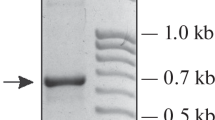Abstract
Nucleotide sequences of 5S rRNA genes (5S rDNA) of 26 wild species of the genus Solanum (sect. Petota) originating from Middle or South America, four Solanum tuberosum breeding lines and one European species, Solanum dulcamara (sect. Dulcamara) were compared with each other and with the 5S rDNA of Lycopersicon esculentum. The length of the repeat ranges from 285 bp to 349 bp. The complete 5S repeat unit consists of the 120-bp long conserved coding region and of a intergenic spacer with a high variability in the central portion as result of deletions/duplications of short motifs demonstrating sequence similarity to box C in the 5S rRNA coding region. Numerous structural rearrangements found in the spacer region can be applied to design species-specific molecular markers for Solanum species involved in breeding programs. Characteristic insertions/deletions (indels) were used to reconstruct phylogenetic relationships among the species studied. S. dulcamara forms a separate clade; L. esculentum is more related to Solanum species of sect. Petota. Conservation of ancestral 5S spacer organization was demonstrated for the representatives of several series of sect. Petota, both Stellata and Rotata. Further rearrangements of the spacer organization occurred in at least four independent lineages: (1) L. esculentum, (2) ser. Polyadenia, (3) other Stellata species from Middle America (ser. Pinnatisecta and Bulbocastana), (4) superser. Rotata. In this last group, series Megistacroloba and Conocibaccata show a common origin, and separation from ser. Tuberosa. Solanum chacoense and Solanum maglia demonstrate a close relatedness to species of ser. Tuberosa and should be included into this group, whereas Solanum bukasovii should be excluded due to conservation of ancestral spacer organization. Three major subgroups may be distinguished for species from ser. Tuberosa, although a high sequence similarity was found here. Several wild species (diploids Solanum phureja and Solanum spegazzinii) probably participated in the natural origin of tetraploid S. tuberosum;others were later used for crossing in breeding programs (e.g. Solanum demissum). Clear separation of Middle-American Stellata species from South-American Stellata and from Middle-American Rotata polyploids is shown.
Similar content being viewed by others
Author information
Authors and Affiliations
Additional information
Received: 11 January 2001 / Accepted: 18 April 2001
Rights and permissions
About this article
Cite this article
Volkov, R., Zanke, C., Panchuk, I. et al. Molecular evolution of 5S rDNA of Solanum species (sect. Petota): application for molecular phylogeny and breeding. Theor Appl Genet 103, 1273–1282 (2001). https://doi.org/10.1007/s001220100670
Issue Date:
DOI: https://doi.org/10.1007/s001220100670




